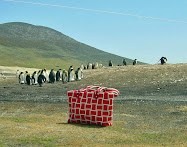Evelyn Dunbar A Land Girl and the Bail Bull 1945
I had a memorable time today at the private view of London's Imperial War Museum's new exhibition Women War Artists here because it's a stunning show and I met up again with two of the contributors. Linda Kitson was the official war artist in the Falklands Conflict (1982) in which my husband was involved and Rozanne Hawksley and I both grew up amongst the Royal Navy in Portsmouth. More about both of them later.
Funny, except it isn't, how so many women artists get written out of art history or are simply undervalued. Naturally I had heard of Laura Knight whom I wrote about here last year. But others who documented both world wars were unknown to me. Not only were they highly competent painters and illustrators but they had an unflinching and compassionate eye for what was going on in the margins of a nation at war - the hospitals, the factories, the aftermath of bombing raids and the plight of the elderly, the children, the wounded and the prisoners.
Norah Neilson-Gray The Scottish Women's Hospital: In The Cloister of the Abbaye at Royaumont. Dr Frances Ivens inspecting a French patient 1920
Doris Zinkeisen Human Laundry, Belsen: April 1945 1945 Each stall in the stable had a table on which the patients were washed by German prisoners before being treated in hospital
Stella Schmolle The Dough Room: Aldershot Command Bakery 1943
Ethel Gabain Sandbag Filling, Islington Borough Council 1941
Anna Airy A Shell Forge at a National projectile Factory, Hackney Marshes, London 1918
Priscilla Thornycroft Runaway Horse in an Air Raid Alarm 1939 - painted in 1955 it was an image that had stayed in the artist's mind
As you can see, the work in this exhibition is poignant, wry, shocking, resonant, relevant.
Also featured are contemporary artists like Mona Hatoum whose mother was caught up in the conflict in Palestine and Frauke Eigen who deals with ethnic cleansing in Kosovo. There is just too much powerful commentary and eye-witness for me to include, alas. Curated by Kathleen Palmer, her accompanying book is outstanding in the quality of the illustrations, the documentation and the analysis.
In 1982 when Argentina invaded the Falkland Islands Linda Kitson was commissioned to accompany the Task Force that sailed to regain them. Although she was originally intended to disembark at Ascension Island she became the first woman artist to accompany troops throughout the campaign. Having met her, one can imagine her response to any man ordering her to pack up and retreat to a safer place. She produced many drawings like this which may appear provisional but exactly capture the immediacy, the drama and the detail of the moment.
Linda Kitson 2nd Battalion Scots Guards in the Sheep Sheds at Fitzroy, 17 June 1982
Linda Kitson Sir Galahad Moored at Fitzroy. She continued to burn until she was towed out to sea and sunk as a war grave. 16 June 1982
Linda Kitson 'The only important thing is to save is this portfolio of drawings please..' 1982
Incidentally, whilst at the Imperial War Museum today I was told this true story. When Margaret Thatcher, who was Prime Minister during the Falklands War, was introduced to an Argentinian general many years later, she simply said to him 'Don't do it again!' and walked away.
Finally, it was a treat to see Rozanne Hawksley whom I had met on board HMS Belfast. The cruiser that had served in the Arctic convoys in World War II is moored in the Thames as an annex of the Imperial War Museum. Hawksley's installation on the theme of memento mori with references to her grandmother's stitching of blue jean collars resonated with me because like her I had grown up in the major naval port of Portsmouth and vividly remember the Guildhall Square packed with servicemen on Remembrance Sunday in the postwar era.
Rozanne Hawksley For Alice Hunter (her grandmother who sewed them)
Rozanne Hawksley Memorial Wreath featuring the skull of a seagull, the traditional black Macclesfield silk square that was rolled into a tie round the sailor's collar and the cap tally
Her iconic Pale Armistice 1991 in the collection of the Imperial War Museum and part of the Women War Artists exhibition.
Although Rozanne confessed to being 80 she is the most lively and engaging company. We somehow found ourselves drinking more wine than was really good for us at lunchtime. I staggered home on the no. 388 with three new books, some postcards and, unaccountably,
a not terribly small toy rabbit. My old man told me I was worse than one of his sailors on a typical run ashore ..
Acknowledgment: the Imperial War Museum for all the illustrations.





















































